Around the World
November/December 2020
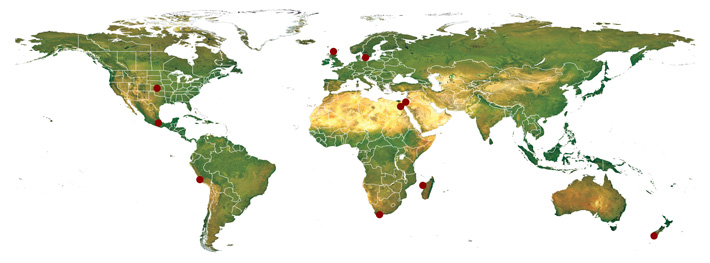

-
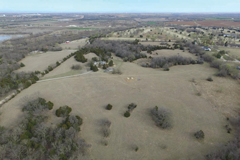 KANSAS: Imaging technology mounted on drones has identified the outline of a previously unknown earthen feature in southeastern Kansas. The 164-foot-diameter monument is likely one of the enigmatic “council circles” built by ancestral Wichita communities. These may have been used for ceremonial rituals, as residences for tribal elites, or for defensive purposes. The earthworks may once have been part of the lost settlement of Etzanoa, which was one of the largest Native American communities in North America before being abandoned around 1700.
KANSAS: Imaging technology mounted on drones has identified the outline of a previously unknown earthen feature in southeastern Kansas. The 164-foot-diameter monument is likely one of the enigmatic “council circles” built by ancestral Wichita communities. These may have been used for ceremonial rituals, as residences for tribal elites, or for defensive purposes. The earthworks may once have been part of the lost settlement of Etzanoa, which was one of the largest Native American communities in North America before being abandoned around 1700. -
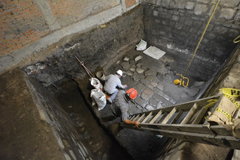 MEXICO: Portions of two historic buildings, one atop the other, were revealed during renovation work in the heart of Mexico City. The upper structure included flooring and walls that belonged to the home of Hernán Cortés, the Spanish conquistador who sacked the Aztec capital in 1521. Ten feet below these remains, workers uncovered stone slabs from the palace of Axayácatl, father of the Aztec emperor Moctezuma II. After the Spanish captured the city, they tore down the palace and reused its materials to construct Cortés’ residence.
MEXICO: Portions of two historic buildings, one atop the other, were revealed during renovation work in the heart of Mexico City. The upper structure included flooring and walls that belonged to the home of Hernán Cortés, the Spanish conquistador who sacked the Aztec capital in 1521. Ten feet below these remains, workers uncovered stone slabs from the palace of Axayácatl, father of the Aztec emperor Moctezuma II. After the Spanish captured the city, they tore down the palace and reused its materials to construct Cortés’ residence. -
 PERU: One of the keys to the Inca Empire’s prosperity was bird guano harvested from islands off coastal Peru and northern Chile. The waste from seabirds such as cormorants and pelicans was an excellent fertilizer and was transported to the Inca highlands and other less fertile areas to boost agricultural productivity. The Inca even implemented stringent restrictions to safeguard the birds’ breeding grounds, and violations were punishable by death. Researchers say this may be the earliest conservation scheme created by humans to protect an animal species and its natural habitat.
PERU: One of the keys to the Inca Empire’s prosperity was bird guano harvested from islands off coastal Peru and northern Chile. The waste from seabirds such as cormorants and pelicans was an excellent fertilizer and was transported to the Inca highlands and other less fertile areas to boost agricultural productivity. The Inca even implemented stringent restrictions to safeguard the birds’ breeding grounds, and violations were punishable by death. Researchers say this may be the earliest conservation scheme created by humans to protect an animal species and its natural habitat. -
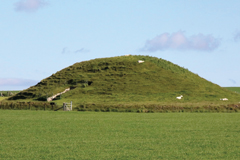 SCOTLAND: The famous 4,800-year-old Maeshowe passage grave on Orkney may have been designed to facilitate the deceased’s journey into the afterworld. A new study indicates that the tomb’s 3 side chambers, which branch off the large central chamber, may have been fashioned with inverted architectural elements the researcher likens to upside-down wallpaper. The tomb’s Neolithic builders envisioned the hereafter as the inverse of life on Earth. The doorways into the tomb’s side chambers may have acted as portals into the afterlife.
SCOTLAND: The famous 4,800-year-old Maeshowe passage grave on Orkney may have been designed to facilitate the deceased’s journey into the afterworld. A new study indicates that the tomb’s 3 side chambers, which branch off the large central chamber, may have been fashioned with inverted architectural elements the researcher likens to upside-down wallpaper. The tomb’s Neolithic builders envisioned the hereafter as the inverse of life on Earth. The doorways into the tomb’s side chambers may have acted as portals into the afterlife. -
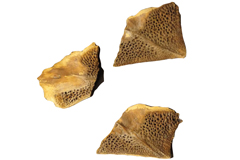 SWEDEN: In 1495, King Hans of Denmark boarded a ship bound for Sweden, where he intended to lay claim to its throne. He traveled with a cargo meant to impress the Swedish nobles. However, his ship, Gribshunden, soon sank near the town of Ronneby. An investigation of the wreck site has recovered a wooden barrel that, to the divers’ surprise, contained the well-preserved remains of a 6-foot-long Atlantic sturgeon. The highly prized fish was likely meant to be served as a prestige food item, conveying the Danish king’s high status to his Swedish hosts.
SWEDEN: In 1495, King Hans of Denmark boarded a ship bound for Sweden, where he intended to lay claim to its throne. He traveled with a cargo meant to impress the Swedish nobles. However, his ship, Gribshunden, soon sank near the town of Ronneby. An investigation of the wreck site has recovered a wooden barrel that, to the divers’ surprise, contained the well-preserved remains of a 6-foot-long Atlantic sturgeon. The highly prized fish was likely meant to be served as a prestige food item, conveying the Danish king’s high status to his Swedish hosts. -
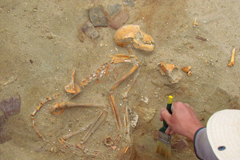 EGYPT: Under Roman rule, the Red Sea port of Berenice blossomed into an important trade hub, connecting Africa with India during the 1st and 2nd centuries A.D. Excavation of an animal necropolis revealed that along with spices, textiles, and luxury goods, rhesus macaques were also imported from across the Indian Ocean, to be kept as household pets. The skeletons of more than a dozen of the Indian monkeys were found carefully buried, some surrounded by grave goods and positioned like sleeping children.
EGYPT: Under Roman rule, the Red Sea port of Berenice blossomed into an important trade hub, connecting Africa with India during the 1st and 2nd centuries A.D. Excavation of an animal necropolis revealed that along with spices, textiles, and luxury goods, rhesus macaques were also imported from across the Indian Ocean, to be kept as household pets. The skeletons of more than a dozen of the Indian monkeys were found carefully buried, some surrounded by grave goods and positioned like sleeping children. -
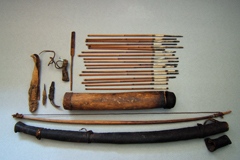 SOUTH AFRICA: Applying poison to arrows has great benefits. The projectile does not have to be very substantial or to be shot with great force to cause a lethal wound—it only needs to penetrate deep enough for the poison to enter the bloodstream. An analysis of bone arrowheads from Blombos Cave indicates that this technology may date back 72,000 years. The shape and small size of the points found there suggests that they were likely coated in toxins; otherwise their diminutive nature would have rendered them virtually ineffective.
SOUTH AFRICA: Applying poison to arrows has great benefits. The projectile does not have to be very substantial or to be shot with great force to cause a lethal wound—it only needs to penetrate deep enough for the poison to enter the bloodstream. An analysis of bone arrowheads from Blombos Cave indicates that this technology may date back 72,000 years. The shape and small size of the points found there suggests that they were likely coated in toxins; otherwise their diminutive nature would have rendered them virtually ineffective. -
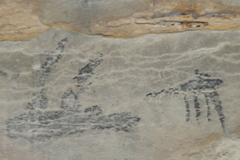 MADAGASCAR: Unique rock art in a remote part of western Madagascar is baffling experts. The black charcoal drawings, which were found in Andriamamelo Cave, depict anthropomorphic and zoomorphic figures, including the now extinct megafaunal sloth lemur, in ceremonial and hunting scenes. At this point, archaeologists are unsure how old the petroglyphs are. One theory holds that they may have been created more than 2,000 years ago, based on some of the compositions’ similarities to Ptolemaic Egyptian motifs, including constellations.
MADAGASCAR: Unique rock art in a remote part of western Madagascar is baffling experts. The black charcoal drawings, which were found in Andriamamelo Cave, depict anthropomorphic and zoomorphic figures, including the now extinct megafaunal sloth lemur, in ceremonial and hunting scenes. At this point, archaeologists are unsure how old the petroglyphs are. One theory holds that they may have been created more than 2,000 years ago, based on some of the compositions’ similarities to Ptolemaic Egyptian motifs, including constellations. -
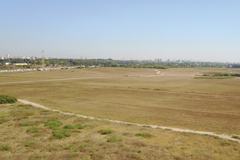 ISRAEL: Researchers have finally determined the location of the Battle of Arsuf, a key engagement in the Third Crusade (1189–1192). Relying on historical documents, environmental analysis, and material evidence, archaeologists pinpointed the spot on the Sharon Plain, north of modern-day Tel Aviv, where Christian troops led by Richard the Lionheart defeated the Muslim army of the sultan Saladin. Although the European forces won the battle that day, they ultimately failed to recapture Jerusalem, and returned home in 1192.
ISRAEL: Researchers have finally determined the location of the Battle of Arsuf, a key engagement in the Third Crusade (1189–1192). Relying on historical documents, environmental analysis, and material evidence, archaeologists pinpointed the spot on the Sharon Plain, north of modern-day Tel Aviv, where Christian troops led by Richard the Lionheart defeated the Muslim army of the sultan Saladin. Although the European forces won the battle that day, they ultimately failed to recapture Jerusalem, and returned home in 1192. -
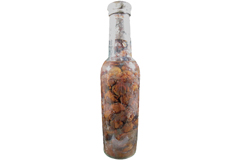 NEW ZEALAND: Demolition of 43 buildings in Invercargill is providing a fascinating glimpse of what the city’s downtown area looked like in the late 19th and early 20th centuries. Newly uncovered remains represent a variety of businesses once located there, including banks, restaurants, a soda and cordial manufacturing company, a newspaper office, and other merchants. As many as 14 wells once used for rubbish disposal were found filled with a wealth of contemporaneous, and sometimes unusual, material, such as a sealed bottle of olives.
NEW ZEALAND: Demolition of 43 buildings in Invercargill is providing a fascinating glimpse of what the city’s downtown area looked like in the late 19th and early 20th centuries. Newly uncovered remains represent a variety of businesses once located there, including banks, restaurants, a soda and cordial manufacturing company, a newspaper office, and other merchants. As many as 14 wells once used for rubbish disposal were found filled with a wealth of contemporaneous, and sometimes unusual, material, such as a sealed bottle of olives.
Advertisement
IN THIS ISSUE
Digs & Discoveries
Our Coastal Origins
Off the Grid
A Day by the Rhone
Painful Past
Miniature Masterpieces
Precision Instruments
Ship of Plenty
A Tale of Two Pipes
To Reach the Gods
Bronze Age Keepsakes
Honoring the Dead
Paleolithic Bedtime
Laurens' Last Stand
Piggy Playthings
What's in a Norse Name?
Around the World
Poison projectiles, Cortés’ Mexico City abode, Peruvian pelican fertilizer, and solving a Crusader mystery
Artifact
Turning over an old leaf
Advertisement

Recent Issues
-
 May/June 2024
May/June 2024
-
 March/April 2024
March/April 2024
-
 January/February 2024
January/February 2024
-
 November/December 2023
November/December 2023
-
 September/October 2023
September/October 2023
-
 July/August 2023
July/August 2023
-
 May/June 2023
May/June 2023
-
 March/April 2023
March/April 2023
-
 January/February 2023
January/February 2023
-
 November/December 2022
November/December 2022
-
 September/October 2022
September/October 2022
-
 July/August 2022
July/August 2022
-
 May/June 2022
May/June 2022
-
 March/April 2022
March/April 2022
-
 January/February 2022
January/February 2022
-
 November/December 2021
November/December 2021
-
 September/October 2021
September/October 2021
-
 July/August 2021
July/August 2021
-
 May/June 2021
May/June 2021
-
 March/April 2021
March/April 2021
-
 January/February 2021
January/February 2021
-
 November/December 2020
November/December 2020
-
 September/October 2020
September/October 2020
-
 July/August 2020
July/August 2020
-
 May/June 2020
May/June 2020
-
 March/April 2020
March/April 2020
-
 January/February 2020
January/February 2020
-
 November/December 2019
November/December 2019
-
 September/October 2019
September/October 2019
-
 July/August 2019
July/August 2019
-
 May/June 2019
May/June 2019
-
 March/April 2019
March/April 2019
-
 January/February 2019
January/February 2019
-
 November/December 2018
November/December 2018
-
 September/October 2018
September/October 2018
-
 July/August 2018
July/August 2018
-
 May/June 2018
May/June 2018
-
 March/April 2018
March/April 2018
-
 January/February 2018
January/February 2018
-
 November/December 2017
November/December 2017
-
 September/October 2017
September/October 2017
-
 July/August 2017
July/August 2017
-
 May/June 2017
May/June 2017
-
 March/April 2017
March/April 2017
-
 January/February 2017
January/February 2017
-
 November/December 2016
November/December 2016
-
 September/October 2016
September/October 2016
-
 July/August 2016
July/August 2016
-
 May/June 2016
May/June 2016
-
 March/April 2016
March/April 2016
-
 January/February 2016
January/February 2016
-
 November/December 2015
November/December 2015
-
 September/October 2015
September/October 2015
-
 July/August 2015
July/August 2015
-
 May/June 2015
May/June 2015
-
 March/April 2015
March/April 2015
-
 January/February 2015
January/February 2015
-
 November/December 2014
November/December 2014
-
 September/October 2014
September/October 2014
-
 July/August 2014
July/August 2014
-
 May/June 2014
May/June 2014
-
 March/April 2014
March/April 2014
-
 January/February 2014
January/February 2014
-
 November/December 2013
November/December 2013
-
 September/October 2013
September/October 2013
-
 July/August 2013
July/August 2013
-
 May/June 2013
May/June 2013
-
 March/April 2013
March/April 2013
-
 January/February 2013
January/February 2013
-
 November/December 2012
November/December 2012
-
 Sep/Oct 2012
Sep/Oct 2012
-
 September/October 2012
September/October 2012
-
 July/August 2012
July/August 2012
-
 May/June 2012
May/June 2012
-
 March/April 2012
March/April 2012
-
 January/February 2012
January/February 2012
-
 November/December 2011
November/December 2011
-
 September/October 2011
September/October 2011
-
 July/August 2011
July/August 2011
-
 May/June 2011
May/June 2011
-
 March/April 2011
March/April 2011
-
 January/February 2011
January/February 2011
Advertisement






